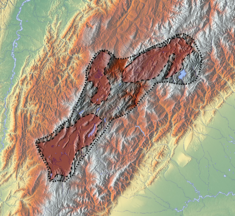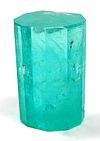
The Muisca are an indigenous people and culture of the Altiplano Cundiboyacense, Colombia, that formed the Muisca Confederation before the Spanish conquest. The people spoke Muysccubun, a language of the Chibchan language family, also called Muysca and Mosca. They were encountered by conquistadors dispatched by the Spanish Empire in 1537 at the time of the conquest.
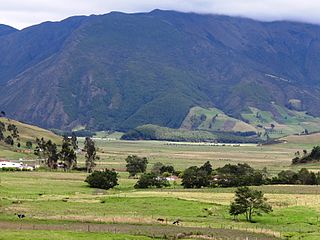
The Altiplano Cundiboyacense is a high plateau located in the Eastern Cordillera of the Colombian Andes covering parts of the departments of Cundinamarca and Boyacá. The altiplano corresponds to the ancient territory of the Muisca. The Altiplano Cundiboyacense comprises three distinctive flat regions; the Bogotá savanna, the valleys of Ubaté and Chiquinquirá, and the valleys of Duitama and Sogamoso. The average altitude of the altiplano is about 2,600 metres (8,500 ft) above sea level but ranges from roughly 2,500 metres (8,200 ft) to 4,000 metres (13,000 ft).

El Infiernito, is a pre-Columbian archaeoastronomical site located on the Altiplano Cundiboyacense in the outskirts of Villa de Leyva, Boyacá, Colombia. It is composed of several earthworks surrounding a setting of menhirs ; several burial mounds are also present. The site was a center of religious ceremonies and spiritual purification rites, and also served as an astronomical observatory.
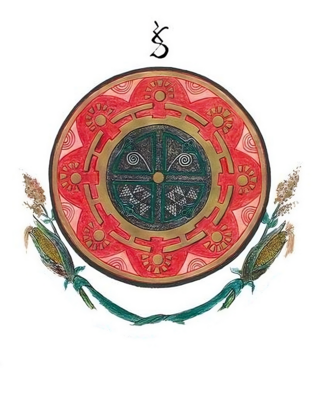
The Muisca Confederation was a loose confederation of different Muisca rulers in the central Andean highlands of what is today Colombia before the Spanish conquest of northern South America. The area, presently called Altiplano Cundiboyacense, comprised the current departments of Boyacá, Cundinamarca and minor parts of Santander.
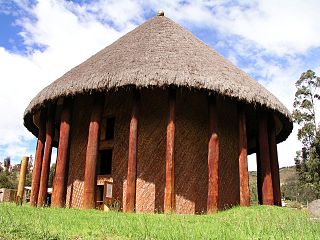
Idacansás, Idacansas, Idacanzas or Iduakanzas was a mythical cacique who was said to have been the first priest of the sacred city of Sugamuxi, present-day Sogamoso, Colombia, then part of the territories of the Muisca. He is characterized by his great magical powers as he could make rain and hail and transmit diseases and warmth.

Chiminigagua, Chiminichagua or Chimichagua was the supreme being, omnipotent god and creator of the world in the religion of the Muisca. The Muisca and their confederation were one of the four advanced civilizations of the Americas and developed their own religion on the Altiplano Cundiboyacense in the Andes.

Sué, Xué, Sua, Zuhe or Suhé was the god of the Sun in the religion of the Muisca. He was married to Moon goddess Chía. The Muisca and their confederation were one of the four advanced civilizations of the Americas and developed their own religion on the Altiplano Cundiboyacense in the Andes. Both the Sun and rain, impersonated by Chibchacum, were very important for their agriculture.

The Muisca calendar was a lunisolar calendar used by the Muisca. The calendar was composed of a complex combination of months and three types of years were used; rural years, holy years, and common years. Each month consisted of thirty days and the common year of twenty months, as twenty was the 'perfect' number of the Muisca, representing the total of extremeties; fingers and toes. The rural year usually contained twelve months, but one leap month was added. This month represented a month of rest. The holy year completed the full cycle with 37 months.

Muisca religion describes the religion of the Muisca who inhabited the central highlands of the Colombian Andes before the Spanish conquest of the Muisca. The Muisca formed a confederation of holy rulers and had a variety of deities, temples and rituals incorporated in their culture. Supreme being of the Muisca was Chiminigagua who created light and the Earth. He was not directly honoured, yet that was done through Chía, goddess of the Moon, and her husband Sué, god of the Sun. The representation of the two main celestial bodies as husband and wife showed the complementary character of man and woman and the sacred status of marriage.

Manuel Arturo Izquierdo Peña is a Colombian anthropologist who has contributed to the knowledge of the Muisca and other pre-Columbian cultures, among others San Agustín, Colombia. His main work has been on archaeoastronomy of the Muisca calendar.
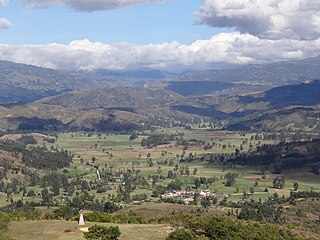
The iraca, sometimes spelled iraka, was the ruler and high priest of Sugamuxi in the confederation of the Muisca who inhabited the Altiplano Cundiboyacense; the central highlands of the Colombian Andes. Iraca can also refer to the Iraka Valley over which they ruled. Important scholars who wrote about the iraca were Lucas Fernández de Piedrahita, Alexander von Humboldt and Ezequiel Uricoechea.

The Moon Temple of Chía was a temple constructed by the Muisca as a place of worship for their Moon goddess Chía. The temple was built in Chía, Cundinamarca, Colombia, then part of the Muisca Confederation. It was one of the most important temples in the religion of the Muisca. The temple was destroyed during the Spanish conquest of the Muisca on the Altiplano Cundiboyacense. Little is known about the temple built on the Tíquiza Hill in western Chía bordering Tabio.

The Muisca agriculture describes the agriculture of the Muisca, the advanced civilisation that was present in the times before the Spanish conquest on the high plateau in the Colombian Andes; the Altiplano Cundiboyacense. The Muisca were a predominantly agricultural society with small-scale farmfields, part of more extensive terrains. To diversify their diet, they traded mantles, gold, emeralds and salt for fruits, vegetables, coca, yopo and cotton cultivated in lower altitude warmer terrains populated by their neighbours, the Muzo, Panche, Guane, Guayupe, Lache, Sutagao and U'wa. Trade of products grown farther away happened with the Calima, Pijao and Caribbean coastal communities around the Sierra Nevada de Santa Marta.

This article describes the architecture of the Muisca. The Muisca, inhabiting the central highlands of the Colombian Andes, were one of the four great civilizations of the Americas. Unlike the three civilizations in present-day Mexico and Peru, they did not construct grand architecture of solid materials. While specialising in agriculture and gold-working, cloths and ceramics, their architecture was rather modest and made of non-permanent materials as wood and clay.

The Muisca inhabited the Altiplano Cundiboyacense in the Colombian Andes before the arrival of the Spanish and were an advanced civilisation. They mummified the higher social class members of their society, mainly the zipas, zaques, caciques, priests and their families. The mummies would be placed in caves or in dedicated houses ("mausoleums") and were not buried.

This article describes the economy of the Muisca. The Muisca were the original inhabitants of the Altiplano Cundiboyacense, the high plateau in the Eastern Ranges of central present-day Colombia. Their rich economy and advanced merchant abilities were widely known by the indigenous groups of the area and described by the Spanish conquistadores whose primary objective was the acquisition of the mineral resources of Tierra Firme; gold, emeralds, carbon, silver and copper.

This article describes the art produced by the Muisca. The Muisca established one of the four grand civilisations of the pre-Columbian Americas on the Altiplano Cundiboyacense in present-day central Colombia. Their various forms of art have been described in detail and include pottery, textiles, body art, hieroglyphs and rock art. While their architecture was modest compared to the Inca, Aztec and Maya civilisations, the Muisca are best known for their skilled goldworking. The Museo del Oro in the Colombian capital Bogotá houses the biggest collection of golden objects in the world, from various Colombian cultures including the Muisca.





